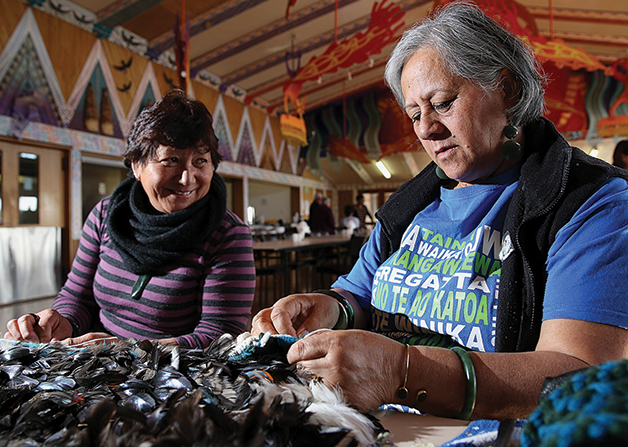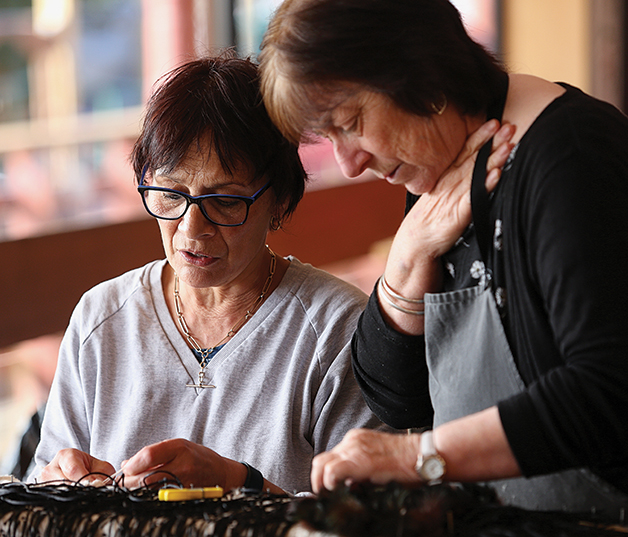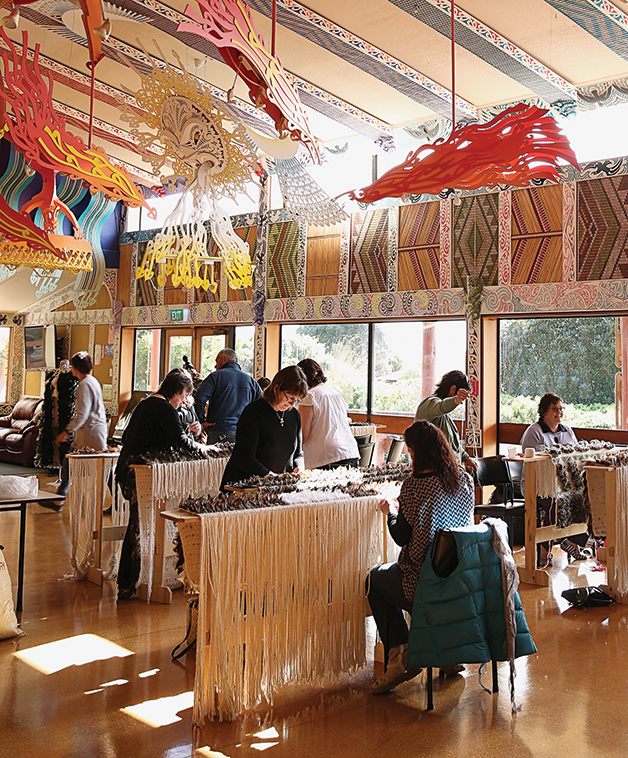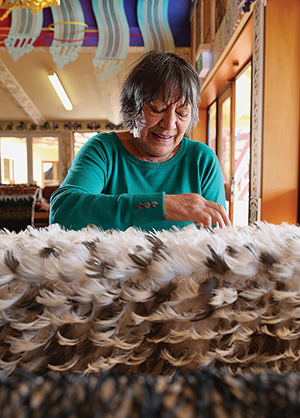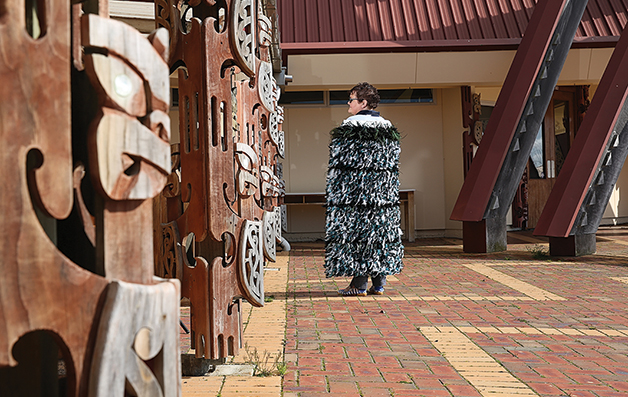Toi IhoWeaving
Sept 27, 2016

A series of wānanga being held in the deep south have reignited a passion and excitement among the local wāhine for the traditional practice of weaving.
Kaituhi Anna Brankin reports.
Aitia te wahine o te pā harakeke – marry the woman of the flax cultivation. This whakataukī is a reminder of the historical importance of weaving to Māori. Weavers, who were mostly women, used harakeke and other plants to produce objects ranging from the practical (food baskets and floor mats) to the treasured and prestigious (korowai and tāniko). From the early 20th century, weaving became less common as the accessibility of mass-produced household items and clothing meant it was no longer integral to daily life.
However, in recent years a growing trend of cultural revitalisation has seen many communities regain the knowledge of these traditional practices. Maata McManus (Waikato Tainui) is renowned for her skill in weaving korowai, the prestigious feathered cloak worn at significant occasions such as tangi, weddings and graduations. Maata is committed to ensuring that her knowledge is passed on, saying: “When I first started teaching, the art was starting to die. I’m very passionate about it because I think it’s about whanaungatanga, whakapapa, manaakitanga. It’s about bringing people together.”
Well, the people have been brought together at Te Rau Aroha Marae, where the Awarua Rūnanga has been able to enlist Maata’s tutelage and host a series of wānanga that teach participants the skills to weave a korowai. Awarua kaumātua Hana Morgan (Ngāi Tahu – Awarua, Puketeraki, Moeraki, Taumutu, Waihōpai), a talented weaver in her own right, has been behind this kaupapa from the start, saying: “We are so fortunate to be able to have Maata to come down from Tainui to do this, to support and teach our women. These women have never done this mahi before, and the opportunity has been created thanks to the Ngāi Tahu Fund. I’m absolutely thrilled.” Hana’s expertise in tāniko, the skill used to weave the intricate borders of cloaks, means that she has been able to provide invaluable support to the students. Furthermore, the respect she has earned as a longstanding member of the Awarua community has brought mana to the project as a whole.
The wānanga began in June 2015, and take place on a monthly basis. I have been privileged enough to attend two of these wānanga and meet the women who have taken up this challenge, observe their progress, and learn more about their journeys.
The first thing I noticed when I arrived at Te Rau Aroha Marae on a foggy Friday evening in early August was the buzz that emanated throughout the whare. Wāhine moved back and forth throughout the space, setting up their looms, preparing the feathers for their korowai and admiring one another’s progress since they last gathered together.
As I walked around the room, I discovered that while everyone had their own unique story to share, they all wanted to express their gratitude to the Ngāi Tahu Fund and Awarua Rūnanga for providing this opportunity for them. The students were overwhelmed by the patience, wisdom and guidance that they received from Maata.
Maata is an old hand at this, having established Te Korowai o Maata 18 years ago at her home, Tūrangawaewae Marae in Ngāruawāhia. The wānanga at Te Rau Aroha follow the tried and true formula that Maata has used for years: the students begin work at the marae on Friday evening, stay overnight, and continue weaving until Saturday afternoon. Those who have been before carry on with their korowai under the guidance of Maata and two tutors (her mokopuna, Jayden Abraham, and Annie Rewharewha) who accompany her from Ngāruawāhia. First-time students are shown the art of whatu, or finger weaving, before beginning their first project. This is a short cloak using materials provided by Maata: the string and feathers, as well as a loom that can be kept and used again. Once this has been completed, students move onto their whānau korowai, for which they need to source their own feathers.
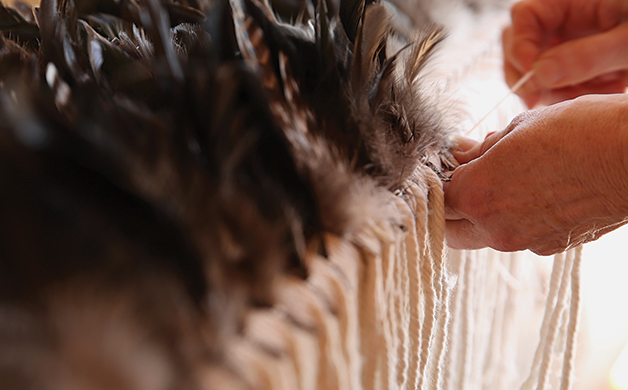
Maata became involved in the Awarua weaving wānanga as a result of her long-standing friendship with rūnanga member Barbara Metzger (Ngāi Tahu – Awarua, Moeraki, Taumutu, Waihōpai). “I met Maata about 20 years ago when we were doing our Kaiāwhina training for Plunket,” says Barbara. “She was weaving way back then, and she took me to the health centre where they’d all been making their little korowai out of feather dusters, and they were amazing. I said, ‘Oh my goodness, one day I’m going to do this.’” Twenty years later, this plan has finally come to fruition.
“When you’re weaving, you start thinking about your tūpuna, you start thinking about your whānau and it brings it right out. I’ve had women who have lost loved ones, who are grieving, and as soon as they put their hands to the korowai it’s brought it out of them and they feel comforted.”
Maata McManus (Waikato Tainui)
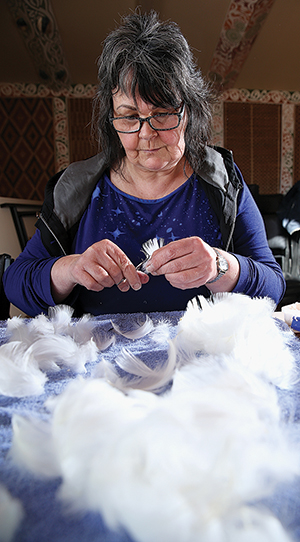
Barbara Metzger preparing feathers for weaving.
For Barbara, the wānanga have been an opportunity to learn the craft of korowai alongside her daughter, Lara Stevens (Ngāi Tahu – Awarua, Moeraki, Taumutu, Waihōpai). The mother-daughter duo has created their whānau korowai together, with Lara undertaking the weaving and Barbara helping to pluck the birds and prepare the feathers. The experience has been very meaningful to the pair.
“My grandfather, mum’s father, has a kiwi feather kākahu,” Lara says. “That’s always been in the family and has always been a very special thing to us. So to be able to learn the skill to make another one that can be passed down to future generations is pretty exciting.”
Lara developed the design for their korowai shortly after she began weaving with some weka feathers she had been given by family friends. “The brown weka feathers represent the land, and then I moved into some greens to represent the bush and nature, and then into coastline and beaches with the lighter brown. I wanted to represent the sea because it’s very important to us, growing up in Bluff, so there’s blue. And because my favourite colour is orange I wanted to finish with Rakiura and the glowing skies.” Barbara and Lara have been able to source the feathers for this design by applying to the Department of Conservation for feathers from rarer birds such as kākāpō, as well as relying on the generosity of whānau and friends who have done everything from sending them sacks full of feathers after a cull, to picking up individual pūkeko on the side of the road. Lara says, “We feel lucky to have these birds in our korowai. To know that these are native birds and that a lot of them have come from this area, that’s pretty special.” Barbara adds, “The kākāpō came from Whenua Hou, and that’s where our people came from back in the day.” The two women are overwhelmed by the support they’ve been given, and plan to acknowledge their whānau and friends by making a booklet that explains the origins of the feathers.
For Barbara, the experience of weaving with Lara has been rewarding in more ways than one. “Lara can be a bit of a stress bunny, so as a mother it’s been really good for me to see her enjoy something so much, and relax and be completely involved in it.” Lara agrees, saying, “It’s quite absorbing, and I look forward to getting home after a stressful day so I can get back into it and see it coming together.”
According to Hana, this feeling is common amongst weavers. “Weaving is good for you, for the wairua. You get into a rhythm and you just keep going. It’s very soothing, very satisfying. It’s good for your wellness. The techniques that you’re using are hundreds and hundreds of years old, so you’re doing what our tūpuna did. It’s a real sense of connection.”
“My grandfather, mum’s father, has a kiwi feather kākahu. That’s always been in the family and has always been a very special thing to us. So to be able to learn the skill to make another one that can be passed down to future generations is pretty exciting.”
Lara Stevens (Ngāi Tahu – Awarua, Moeraki, Taumutu, Waihōpai)
Maata adds that the process of weaving can actually help people during difficult times. “When you’re weaving, you start thinking about your tūpuna, you start thinking about your whānau and it brings it right out. I’ve had women who have lost loved ones, who are grieving, and as soon as they put their hands to the korowai it’s brought it out of them and they feel comforted.”
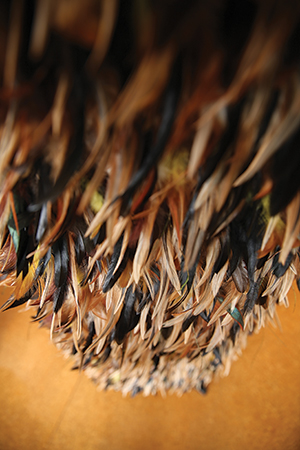 This has certainly been the case for Maira Boyle (Ngāi Tahu – Ngāi Tūāhuriri). Her son’s recent illness has made it difficult for her to attend every wānanga, but she says that working on her korowai has also been a way for her to relieve stress. “I’ve always been a bit spiritual when it comes to my Māori side, and this is a way to channel that. I believe that this is meant to be. I made three attempts to start my whānau korowai and it wasn’t until February, when my son was in a good place, that it just flowed.” As her korowai has progressed, her son has taken an interest in it, and has even contributed by designing the pattern for Maira’s tāniko. “It’s very special that he’s getting involved. I’m so happy that he is part of the whānau korowai.”
This has certainly been the case for Maira Boyle (Ngāi Tahu – Ngāi Tūāhuriri). Her son’s recent illness has made it difficult for her to attend every wānanga, but she says that working on her korowai has also been a way for her to relieve stress. “I’ve always been a bit spiritual when it comes to my Māori side, and this is a way to channel that. I believe that this is meant to be. I made three attempts to start my whānau korowai and it wasn’t until February, when my son was in a good place, that it just flowed.” As her korowai has progressed, her son has taken an interest in it, and has even contributed by designing the pattern for Maira’s tāniko. “It’s very special that he’s getting involved. I’m so happy that he is part of the whānau korowai.”
Helen Wilson (Ngāi Tahu – Ōraka Aparima, Waihōpai) has also had a deeply personal journey as a result of her experience at these wānanga. Her journey began at the beginning of 2015 when her sister Rachel took her to one of Maata’s wānanga in Ngāruawāhia. “I got hooked.
I was trying to work out how exactly I was going to progress after the workshop I’d been to because I wanted to finish. And then I found out that Maata was coming down here!” Helen was not brought up with her Ngāi Tahu culture, and never knew much about it until she visited a marae for a tangi. “I was in my late 30s when that happened. It was a whole culture shock for me. It made me really aware, it was like an awakening. So in a way this project is a bit of a homecoming for me.” Helen chose the feathers for her whānau korowai to reflect this cultural connection, using black and white feathers to represent her Māori and Pākehā heritage respectively, intermingled with blue-green feathers that reflect her connection to the land and the sea.
It is this cultural connection that has driven Joyce Manahi (Ngāti Porou) to attend these wānanga. “I love the traditional side of it,” she says. “It’s not just about learning the techniques, it’s the link back to our tīpuna, and how they used to do it. That’s what I really connect with.” Joyce has completed her first whānau korowai, as well as two tiny cloaks for her mokopuna, and is currently working on her second full-sized one. There will be a graduation ceremony for the wāhine in November, and she is determined to finish before then. “My mum is coming down from Blenheim. She doesn’t know it yet but she’s going to be wearing one of these korowai. One of my daughters is coming back from Australia with my moko and they’ll each be wearing one as well. To see them wearing them altogether when I graduate from this korowai class is going to be amazing.”
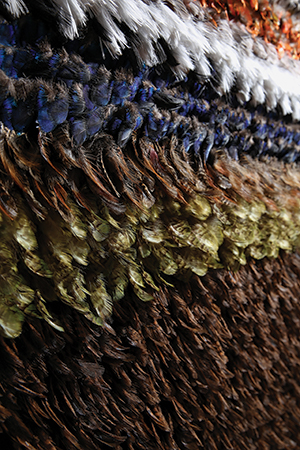 For Hana, seeing this skill become more widespread throughout the community is of special significance. She is renowned for her work weaving harakeke and tāniko, and last year she received Creative New Zealand’s Ngā Tohu ā Tā Kingi Ihaka award in recognition of her outstanding contribution to Māori art. But she has never learned to weave a korowai. “I always meant to. For a family to have their own korowai, it’s very special. It’s theirs, for their occasions, be they happy or sad. And now all these whānau will have their own. What better gift can you give your children?”
For Hana, seeing this skill become more widespread throughout the community is of special significance. She is renowned for her work weaving harakeke and tāniko, and last year she received Creative New Zealand’s Ngā Tohu ā Tā Kingi Ihaka award in recognition of her outstanding contribution to Māori art. But she has never learned to weave a korowai. “I always meant to. For a family to have their own korowai, it’s very special. It’s theirs, for their occasions, be they happy or sad. And now all these whānau will have their own. What better gift can you give your children?”
After spending a day at this wānanga, I am overwhelmed by the manaakitanga of the wāhine who have welcomed me, by the openness with which they have shared their stories and by the incredibly precious taonga they are creating. Above all, it has been heart-warming to see the marae so full of life, bustling with a sense of purpose as the traditions and techniques of our tīpuna are practiced within its walls. Maata tells me that she loves to teach her craft like this, harnessing the mana of the marae to further the cause of cultural revitalisation. And, as Barbara says, “What’s a marae without people? It’s only a big empty building if there aren’t people here.”
